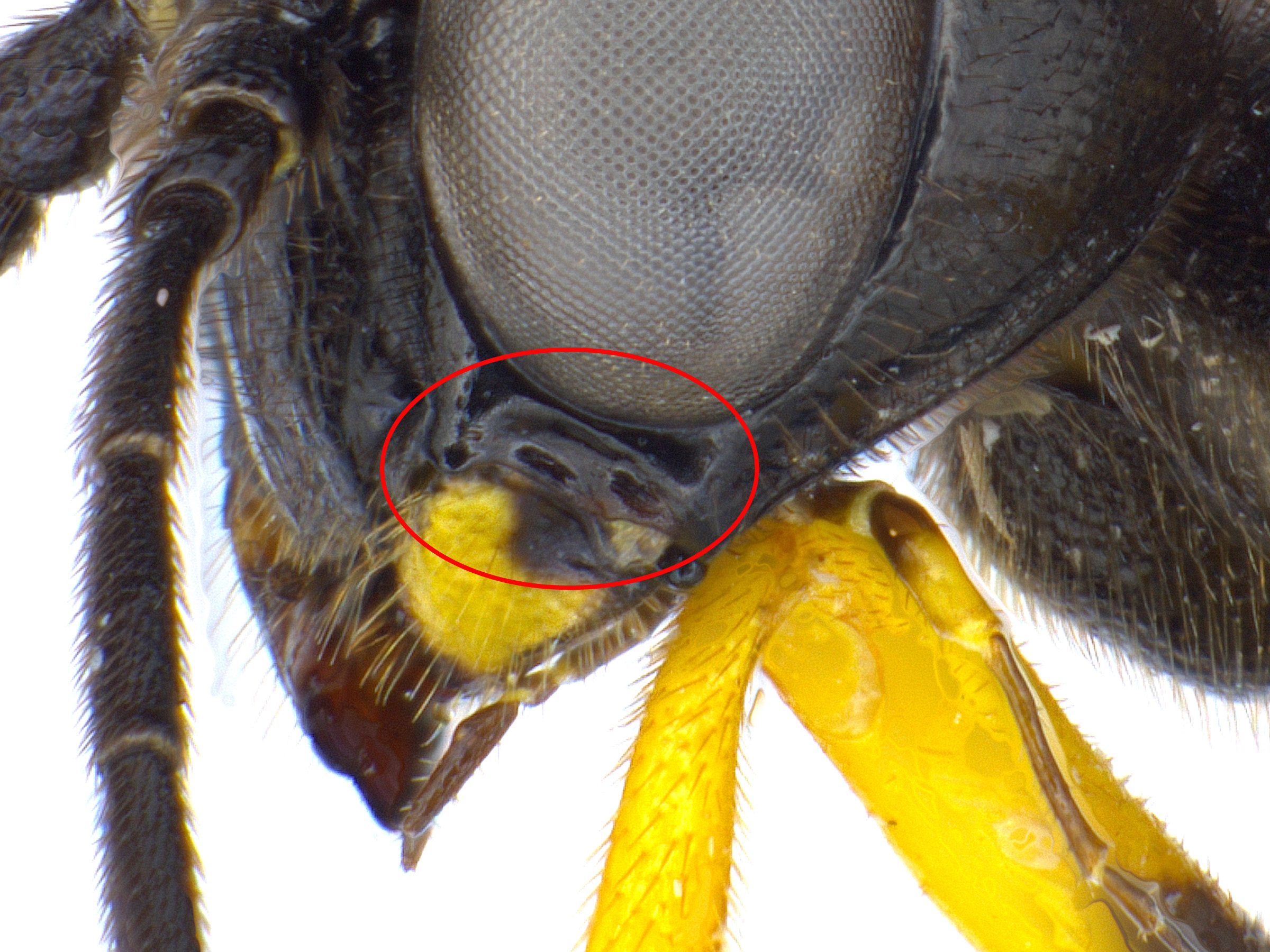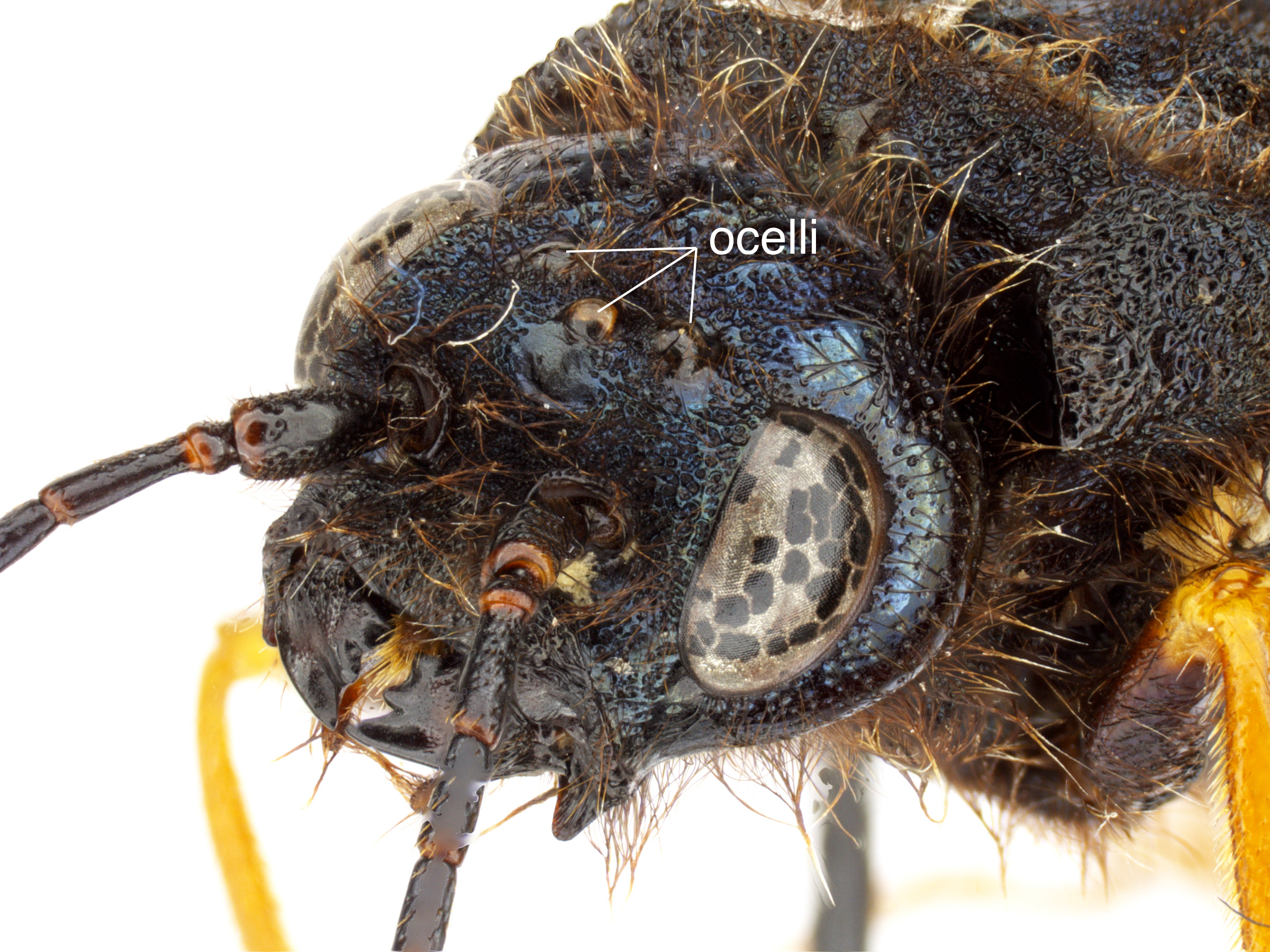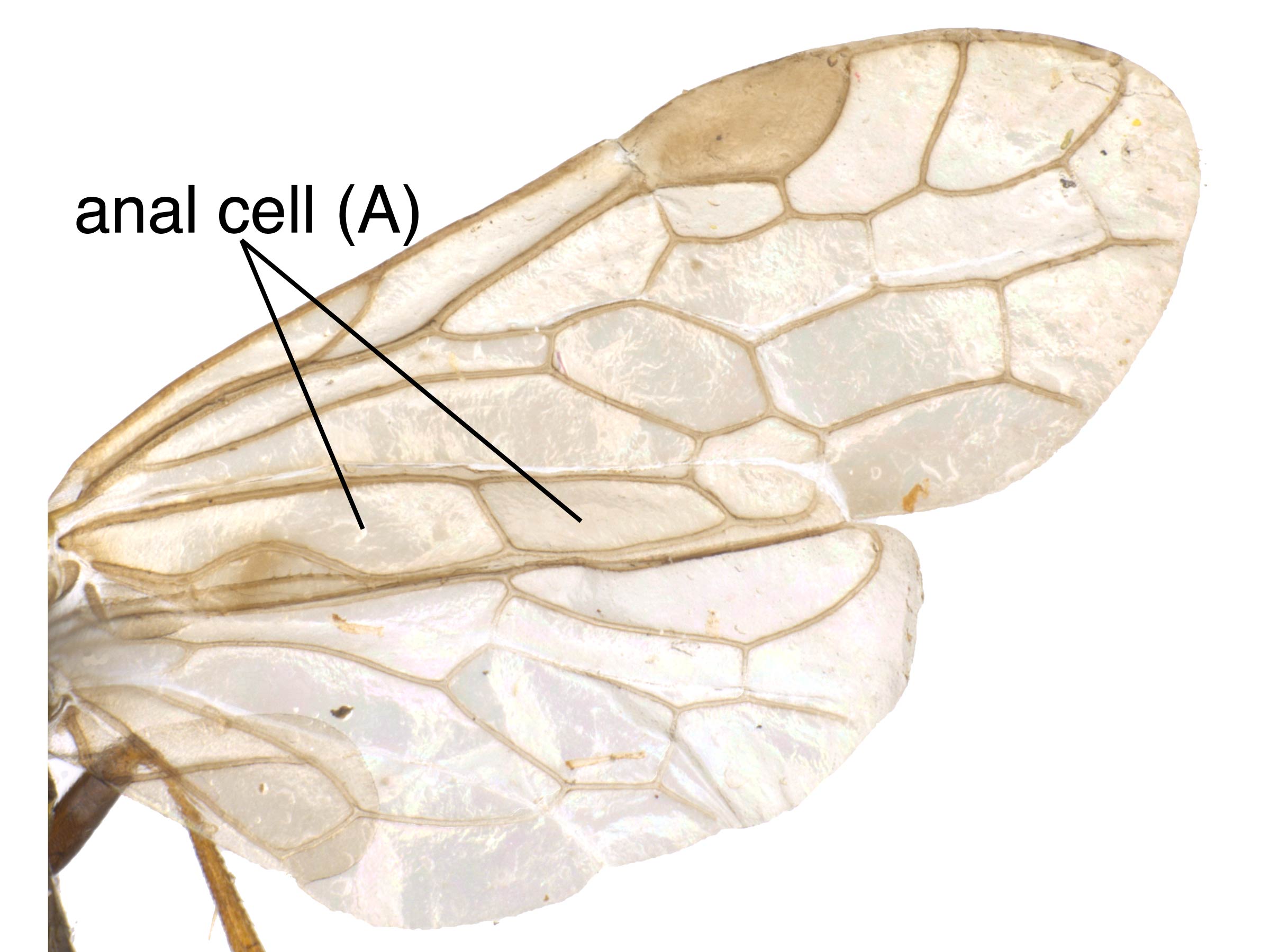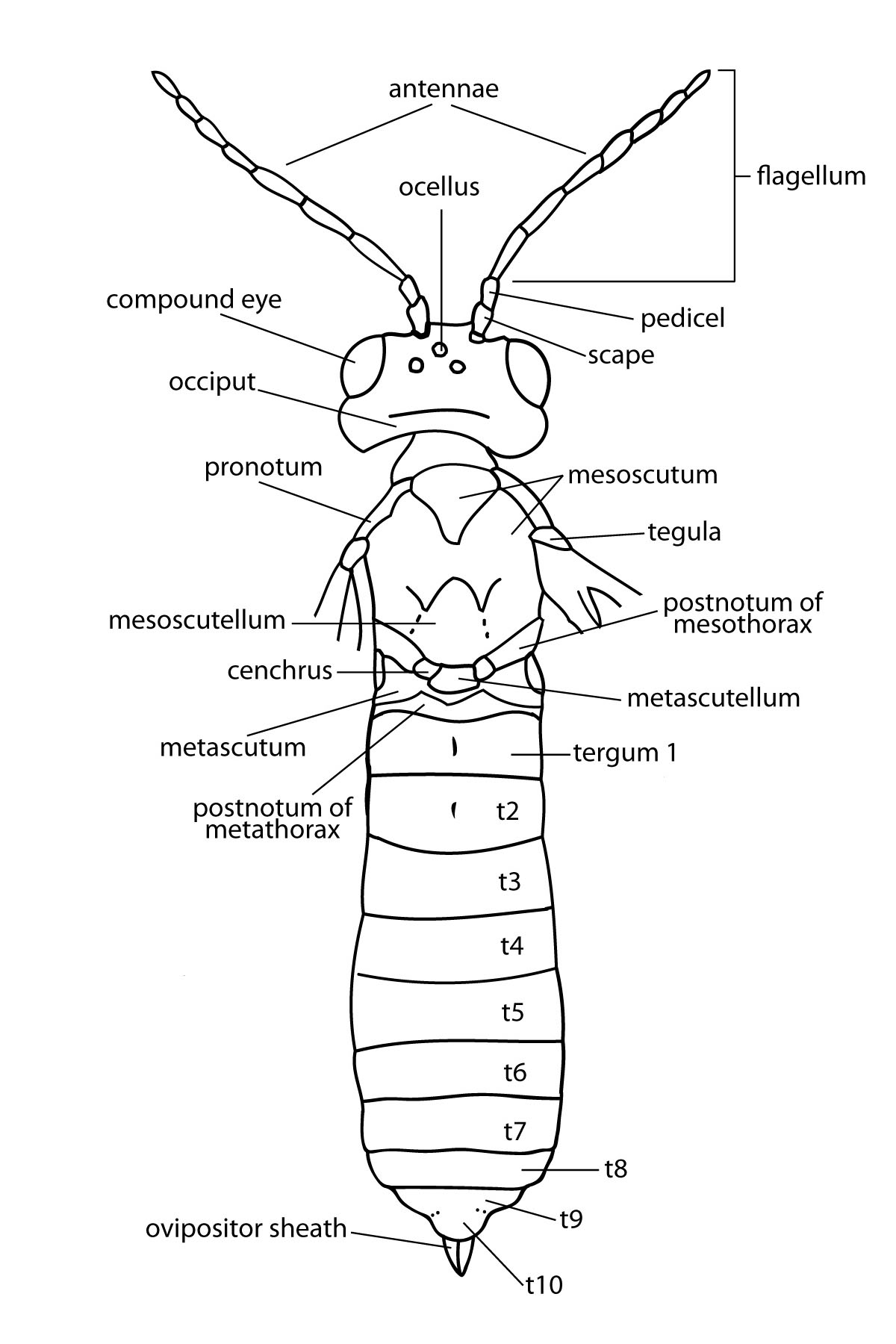Family: Tenthredinidae
Family common name: common sawflies
Subfamily: Selandriinae
Tribe: Aneugmenini
Genus: Birka Malaise, 1944
Subgenera: Birka, Lineobirka
The Tenthredinidae are the most species-rich family and are found throughout the world, in all continents but Antarctica. They are known as the “common sawflies.” They can generally be recognized by a cylindrical body and long, segmented antennaeantenna:
the sensory organ emerging from the front of the head, usually between the compound eyes and above the clypeus; includes the flagellum, scape and pedicel
 . Otherwise, they come in a variety of colors, sizes, and forms (Goulet 1992Goulet 1992:
. Otherwise, they come in a variety of colors, sizes, and forms (Goulet 1992Goulet 1992:
Goulet H. 1992. The genera and subgenera of the sawflies of Canada and Alaska: Hymenoptera. Symphyta. The insects and arachnids of Canada. Part 20. Agriculture Canada Publication.).
Sawflies in the Selandriinae subfamily are relatively small and slender. The range of Selandriinae is worldwide; it occurs on all continents except Antarctica (Goulet 1992Goulet 1992:
Goulet H. 1992. The genera and subgenera of the sawflies of Canada and Alaska: Hymenoptera. Symphyta. The insects and arachnids of Canada. Part 20. Agriculture Canada Publication.). It is the most common and diverse group of tenthredinids in tropical regions, particularly in Central America, South America, and Southeast Asia (Smith 1969eSmith 1969e:
Smith DR. 1969e. Nearctic Sawflies. II. Selandriinae: Adults (Hymenoptera: Tenthredinidae). Technical Bulletin, U.S. Department of Agriculture 1398: 1-48.). Selandriinae contains the only known sawflies that feed on non-vascular plants, specifically ferns (Smith et al. 2013Smith et al. 2013:
Smith DR, Janzen DH and Hallwachs W. 2013. Food plants and life histories of sawflies of the families Argidae and Tenthredinidae (Hymenoptera) in Costa Rica, a supplement. Journal of Hymenoptera Research 35: 17-31. https://doi.org/10.3897/JHR.35.5496). The subfamily can be distinguished from other subfamilies by wing venationvenation:
the network of veins on a wing
(Goulet 1992Goulet 1992:
Goulet H. 1992. The genera and subgenera of the sawflies of Canada and Alaska: Hymenoptera. Symphyta. The insects and arachnids of Canada. Part 20. Agriculture Canada Publication.).
Birka is monotypicmonotypic:
describes having only one representative; ex. a genus that includes only one species
in North America. Birka nordica is small and stout, about 6 mm in length, and mostly black with some white on the thoraxthorax:
the second and middle segment of the body, between the head and abdomen
 . This species is northern in distribution (Smith 1969eSmith 1969e:
. This species is northern in distribution (Smith 1969eSmith 1969e:
Smith DR. 1969e. Nearctic Sawflies. II. Selandriinae: Adults (Hymenoptera: Tenthredinidae). Technical Bulletin, U.S. Department of Agriculture 1398: 1-48.).
There are 17 described extantextant:
in existence; opposite of extinct
species worldwide. One species occurs in North America (Taeger et al. 2010Taeger et al. 2010:
Taeger A, Blank SM, and Liston AD. 2010. World Catalog of Symphyta (Hymenoptera). Zootaxa 2580: 1-1064.).
Subfamily characters
 vein Rs+M curved near intersection with veinvein:
vein Rs+M curved near intersection with veinvein: Sc+R (Smith 1969eSmith 1969e:
Sc+R (Smith 1969eSmith 1969e: vein M meeting Sc+R basalbasal:
vein M meeting Sc+R basalbasal: veins M and m-cu about parallel (Smith 1969eSmith 1969e:
veins M and m-cu about parallel (Smith 1969eSmith 1969e: vein 2r-m present (Goulet 1992Goulet 1992:
vein 2r-m present (Goulet 1992Goulet 1992:Genus characters
 margin straight (Smith 1969eSmith 1969e:
margin straight (Smith 1969eSmith 1969e: length about twice the diameter of front ocellusocellus:
length about twice the diameter of front ocellusocellus: (Smith 1969eSmith 1969e:
(Smith 1969eSmith 1969e: as wide as long (Smith 1969eSmith 1969e:
as wide as long (Smith 1969eSmith 1969e: anal crossveinanal crossvein:
anal crossveinanal crossvein: anal cellanal cell:
anal cellanal cell: petiole present (Goulet 1992Goulet 1992:
petiole present (Goulet 1992Goulet 1992: with small inner tooth (Smith 1969eSmith 1969e:
with small inner tooth (Smith 1969eSmith 1969e:Birka can be confused with similar species in the subfamily Selandriinae or tribe Aneugmenini. It can be distinguished from most other genera by the absence of a fore wingfore wing:
the anterior wing of each pair of wings; usually the largest wing of the pair
 anal crossveinanal crossvein:
anal crossveinanal crossvein:
a crossvein that goes through the center of the basal anal cell
, from closely related Aneugmenus by the lack of an occipitalocciput:
the posterior surface of the head
 ridge, and from Nesoselandria by the malar spacemalar space:
ridge, and from Nesoselandria by the malar spacemalar space:
the minimum distance between the base of the mandible and the ventral margin of the compound eye
 length (Smith 1969eSmith 1969e:
length (Smith 1969eSmith 1969e:
Smith DR. 1969e. Nearctic Sawflies. II. Selandriinae: Adults (Hymenoptera: Tenthredinidae). Technical Bulletin, U.S. Department of Agriculture 1398: 1-48.).
none
No hosts are known for North American Birka. Some species in Europe feed on grasses and sedges (Smith 1969eSmith 1969e:
Smith DR. 1969e. Nearctic Sawflies. II. Selandriinae: Adults (Hymenoptera: Tenthredinidae). Technical Bulletin, U.S. Department of Agriculture 1398: 1-48.). Uniquely for Selandriinae, some species feed on dicots: B. carinifrons in Japan on Lysimachia spp. (loosestrife), B. cinereipes in Finland on Myosotis spp. (forget-me-not), and B. annulitarsis in Czech Republic on Pulmonaria angustifolia (blue lungwort) (Macek 2013Macek 2013:
Macek J. 2013. Descriptions of larvae of Birka annulitarsis and B. cinereipes (Hymenoptera: Symphyta: Tenthredinidae). Acta Entomologica Musei Nationalis Pragae 53(2): 815-819., Shinohara and Ibuki 2017Shinohara and Ibuki 2017:
Shinohara A and Ibuki S. 2017. Host plants and larvae of two dicot-feeding Selandriine sawflies (Hymenoptera, Tenthredinidae) from Japan. Bulletin of the National Museum of Natural Science 43(2): 87-91.).
unknown
World: This genus is known from North America, Europe, and Japan (Taeger et al. 2010Taeger et al. 2010:
Taeger A, Blank SM, and Liston AD. 2010. World Catalog of Symphyta (Hymenoptera). Zootaxa 2580: 1-1064.).
North America: Birka nordica occurs in Alaska, Yukon Territory, British Columbia, Alberta, and Manitoba (Smith 1969eSmith 1969e:
Smith DR. 1969e. Nearctic Sawflies. II. Selandriinae: Adults (Hymenoptera: Tenthredinidae). Technical Bulletin, U.S. Department of Agriculture 1398: 1-48.).
Map data from: GBIF.org (29 October 2019) GBIF Occurrence Download Birka and the Smithsonian National Museum of Natural History Entomology Collection (USNM)
Details about data used for maps can be found here.